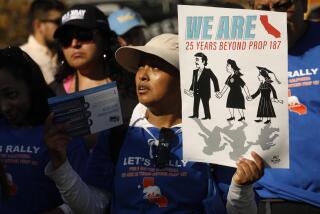Obama administration’s immigration changes begin Wednesday
WASHINGTON -- Immigration authorities are bracing for a deluge of applications Wednesday, the first day when more than 1.2 million young illegal immigrants who were brought to America as children can seek to legally stay and work in the country under a policy change by President Obama.
Even before the first request is filed, critics and advocates alike are warning of potential budget shortfalls and a logjam of paperwork that could mar the initiative, delay processing and facilitate fraud.
Advocacy groups have planned public celebrations, legal aid seminars, and other events in major cities to herald a program that has sparked rejoicing and relief in immigrant communities, and anger among Republicans who view it as a White House ploy for Latino support in an election year and a backdoor amnesty that usurps congressional authority.
The U.S. Citizenship and Immigration Services, which will review the applications, is expecting about 1.2 million applications on top of the 6 million applications it normally adjudicates for citizenship, residency and work visas every year, officials said.
Advocacy groups estimate more than 1.7 million undocumented children and young adults may be eligible, although it’s unknown how many will apply or how quickly. Those granted approval will be given a two-year deferral from deportation and legal authorization to work.
Alejandro Mayorkas, director of U.S. Citizenship and Immigration Services, said application forms would be posted Tuesday afternoon at www.USCIS.gov/childhoodarrivals, and can be submitted starting Wednesday.
“While individual processing times may vary, individual requests will take several months to process,” Mayorkas said.
Some activists worried that a future president could overturn Obama’s order, and that undocumented immigrants who come out of the shadows and turn over their paperwork have no guarantees that they will not be deported if their applications are rejected.
“The undocumented youth I’ve met are so excited about finally being able to be counted, there will be a push to apply on the first day,” said David Leopold, an immigration attorney in Cleveland. “But I think people should take a breath and make sure they do it right, not right now.”
Under the program, officially known as Deferred Action for Childhood Arrivals, undocumented immigrants younger than 31 who came to the United States before the age of 16 are eligible if they are enrolled in school, graduated from high school or served in the U.S. armed forces, and have no criminal record, among other criteria.
When he unveiled the plan at the White House in June, Obama said his order did not offer amnesty or immunity, and did not create a path to citizenship for illegal immigrants. He called it “a temporary stopgap measure” because Congress had failed to act.
Since then, critics have focused on apparent short-comings in the program.
No new workers have been hired to review the school records, sworn affidavits and other documentation each applicant is required to file. And no funds have been appropriated to pay added processing costs by immigration authorities. Officials said the initial budget will be covered by the $465-per-application fee, and as more fees are collected, new staff will be hired.
A similar application for undocumented farm workers to apply under a 1986 amnesty program costs the immigration agency $1,130 to process, two members of Congress wrote in an Aug. 7 letter to Janet Napolitano, secretary of Homeland Security.
In the past, not charging enough to review applications has “resulted in an enormous backlog of legal immigration benefits applications and very long processing wait times for legal immigrants and aspiring U.S. citizens,” wrote Rep. Lamar Smith (R-Texas) and Sen. Charles Grassley (R-Iowa).
On Tuesday, Smith denounced the new program as a “magnet for fraud and abuse” designed to win votes for Obama. “There seems to be little if any mechanism in place for vetting fraudulent applications and documentation submitted by illegal immigrants,” Smith said in a statement.
Applicants must mail completed forms and documentation to one of four immigration service centers: in Laguna Niguel, Calif.; Burlington, Vt.; Dallas, Texas; or Lincoln, Neb. Applicants may follow the progress of their application online.
Officials said application fees will be waived in extreme circumstances, including children living in foster care or in acute poverty.
Among those waiting to apply is Manuel Bartsch, 25, who came to the U.S. from Germany with his parents when he was 11. He says he only learned when he took college placement exams in 2005 that his family never applied for legal residency. He has faced the threat of deportation ever since.
Now Bartsch is collecting transcripts and class schedules from Heidelberg University in Tiffin, Ohio, to submit with his application. If he receives a work permit, he wants to be an intern in a politician’s office, a job he can’t apply for now.
“With this immigration issue, politics has caught my interest,” Bartsch said in a telephone interview.
Ivan Maldonado, 17, who arrived from Mexico when he was 6, will apply so he can finish high school and become a licensed electrician. A resident of Painesville, Ohio, he was ordered deported last year but was allowed to stay because his mother is ill, and needs his help looking after his 5-year-old brother, who is a U.S. citizen.
“They’ve given us hope,” Maldonado said.
[For the Record, 2:54 p.m. PST Aug. 14: An earlier version of this post referred to Sen. Grassley as Rep. Charles Grassley (D-Iowa). It has since been corrected to Sen. Grassley (R-Iowa).]
More to Read
Sign up for Essential California
The most important California stories and recommendations in your inbox every morning.
You may occasionally receive promotional content from the Los Angeles Times.











